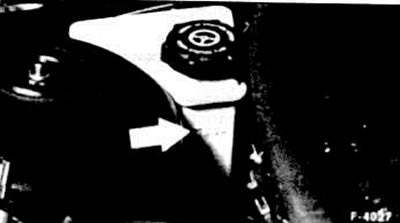Attention! Do not shake the oil before pouring as this will cause air bubbles to form.
Air removal
Fill the reservoir with new, clean and free of air bubbles hydraulic fluid up to the mark "MAX" on the receiver.
Attention! Fill oil slowly to avoid air bubbles.
Start the engine and turn the wheels three times from one extreme position to another.

Watch the oil level in the receiver. Do not allow the level to drop below the mark "MIN", add oil if necessary.
Check at the same time the tightness of the hydraulic system. Piping connections, rail cuffs and valve bodies must be tight.
Stop the engine and check the oil level again, top up if necessary.
Note! It is normal for the hydraulic booster to make slight noise after bleeding while the engine is running. This noise will subsequently disappear when the car is moving.
If the noise of the hydraulic booster is strong, remove the air using an auxiliary vacuum pump.
At the service station, instead of a plug, an adapter is installed on the receiver for connecting a vacuum pump. A suitable adapter can be made from another receiver cover.
Connect the vacuum pump.
Start the engine and slowly turn the steering wheel all the way to the right.
Stop the engine and apply a vacuum of about 0.15 bar with the vacuum pump until the air is completely expelled from the system.
Attention! Maintain the vacuum constant for at least five minutes by equalizing it with a vacuum pump.
Finally, remove the vacuum. Turn the steering wheel all the way to the left and repeat the bleeding process.
Remove the vacuum pump, check the oil level, top up if necessary. Close the receiver cap.
Start the engine and turn the steering wheel from lock to lock. If the noise of the hydraulic booster is increased, repeat the process of bleeding.
If the noise level is still high, leave the vehicle overnight and repeat the bleed process the next day.
Visitor comments